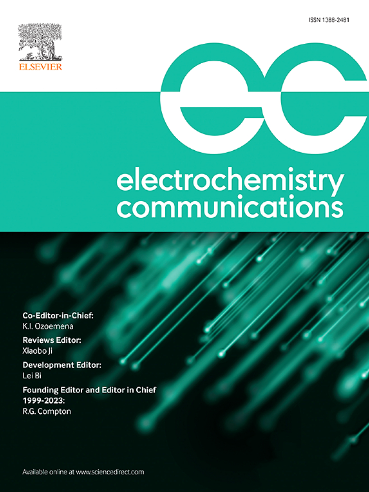Implementing hydrogen oxidation reaction on Pt for controlling counter electrode processes
IF 4.7
3区 工程技术
Q2 ELECTROCHEMISTRY
引用次数: 0
Abstract
The search for active, stable, and durable materials for electrochemical energy technologies requires increasing levels of precision to establish true structure-function relationships and guide materials design from atomic and molecular scale. This increases the level of control required over the experimental system for proper materials evaluation. The choice of counter electrode material become crucial, as Pt dissolution at high voltages may cause contamination to the working electrode, especially when studying reductive processes in reactions such as oxygen reduction reaction (ORR), H2 evolution reaction (HER), and the CO2 reduction reaction. The learnings from “old school” electrochemistry groups lead us to leverage H2 reactions over Pt to construct a counter electrode system with controlled potential that eliminates Pt ion contamination concerns. In here we discuss the construction of such Pt|H2 counter electrode where key experimental aspects such as the H2 flow rate and effective distribution determines the maximum current this counter electrode can accommodate before switching to high voltage and triggering Pt dissolution. Lastly, we demonstrate the use of the Pt|H2 counter electrode in aqueous electrolytes during HER occurring on the working electrode at varying currents, showing that the Pt content in the cell remains below parts per trillion (ppt) up to 10 mA, and below 50 ppt at 100 mA up to 1 h of constant current hold. This work provides a guide to the implementation of Pt|H2 counter electrodes to improve the precision of electrochemical experiments in search of highly active, selective, and durable materials for energy technologies.

在铂上实现氢氧化反应以控制对电极过程
在为电化学能源技术寻找活性、稳定和耐用材料的过程中,需要不断提高精确度,以建立真正的结构-功能关系,并从原子和分子尺度指导材料设计。这就提高了对实验系统的控制水平,以便进行适当的材料评估。对电极材料的选择变得至关重要,因为铂在高电压下的溶解可能会对工作电极造成污染,尤其是在研究氧还原反应(ORR)、H2 演化反应(HER)和 CO2 还原反应等反应中的还原过程时。从 "老派 "电化学小组学到的知识使我们能够利用铂上的 H2 反应来构建具有可控电位的对电极系统,从而消除铂离子污染问题。在这里,我们将讨论这种铂|H2 对电极的构造,其中关键的实验方面,如 H2 的流速和有效分布,决定了这种对电极在切换到高压和触发铂溶解之前所能容纳的最大电流。最后,我们演示了在水性电解质中使用 Pt|H2 对电极在工作电极上以不同电流发生 HER 的过程,结果表明,在 10 mA 电流下,电池中的铂含量仍低于万亿分之一 (ppt);在 100 mA 电流下,铂含量低于 50 ppt,恒流保持时间长达 1 小时。这项研究为使用 Pt|H2 对电极提高电化学实验的精确度提供了指导,从而为能源技术寻找高活性、高选择性和耐用的材料。
本文章由计算机程序翻译,如有差异,请以英文原文为准。
求助全文
约1分钟内获得全文
求助全文
来源期刊

Electrochemistry Communications
工程技术-电化学
CiteScore
8.50
自引率
3.70%
发文量
160
审稿时长
1.2 months
期刊介绍:
Electrochemistry Communications is an open access journal providing fast dissemination of short communications, full communications and mini reviews covering the whole field of electrochemistry which merit urgent publication. Short communications are limited to a maximum of 20,000 characters (including spaces) while full communications and mini reviews are limited to 25,000 characters (including spaces). Supplementary information is permitted for full communications and mini reviews but not for short communications. We aim to be the fastest journal in electrochemistry for these types of papers.
 求助内容:
求助内容: 应助结果提醒方式:
应助结果提醒方式:


